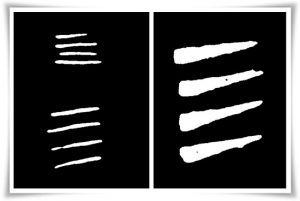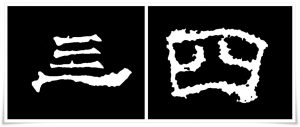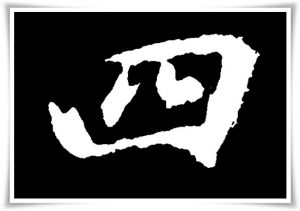
1. Meaning:
four
2. Readings:
- Kunyomi (訓読み): よ, よっ.つ, よ.つ, よん
- Onyomi (音読み): シ
- Japanese names: あ, つ, よつ
- Chinese reading: sì
3. Etymology
四 belongs to the 仮借文字 (かしゃもじ, kashamoji, i.e. rebus {phonetic loan}) characters; or, in other words, characters that were borrowed phonetically to write another homophonic word.

The pre-Han dynasty period (i.e. before the second century B.C.) great seal script (大篆, だいてん, daiten) forms, including oracle bone script (甲骨文, こうこつぶん, kōkotsubun) of the character 四, so called zhou shu (籀書, pinyin: zhòu shū), depict four parallel oblong objects (Figures 1 and 2). This character, similar to the previously discussed character 一 (いち, ichi, i.e. “one”), belongs to the 指事文字 (しじもじ, shiji moji, i.e. characters expressing a simple abstract concept) group of characters. The four lines represent four 算木 (さんぎ, sangi), which were divination rods (small wooden sticks of a shape similar to matches, but longer and thicker). Sangi were also used for calculations.
In “Explaining Simple (Characters) and Analyzing Compound Characters” (說文解字, pinyin: Shūowén Jiězì) from the 2nd century C.E., compiled by Xu Shen (許慎, pinyin: Xǔ Shèn, ca. 58 C.E. – ca. 147 C.E.), a philologist of the Han dynasty (漢朝, pinyin: Hàn cháo, 206 B.C. – 220 C.E.), we read 侌數也。象四分之形。(pinyin: Yīn shǔ yě. Xiàng sì fēn zhī xíng.), which means that 四 is considered Yin (侌, counterpart of the Yang {陽}) element, modelled on a shape divided into four elements (four lines).

However, the modern shape of the character 四 has no ancient forms. The oldest form of this character is found on two of the ten stones of the Sekkobun (石鼓文, せっこぶん, i.e. “stone drum inscription”). The dating of the Stone Drum Inscriptions monuments (ten drums) is rather troublesome, it is estimated to be between the late Western Zhou dynasty (西周, pinyin: Xī Zhōu, 1046 – 771 B.C) , i.e. 8th century B.C., and the late Warring States period (戰國時代, pinyin: Zhànguó shídài, 475 – 221 B.C.), i.e. the late 3rd century B.C.
The character 四 is a phonetic loan character based on 呬 (pinyin: xì, i.e. “to rest”), though with fewer strokes. It is possible that its connection to numbers derived from the concept of laying objects (or people) down, one aside the other.

4. Selected historical forms of 四.
Figure 1. Left: Two forms of the character 四 in Oracle bone script (甲骨文, こうこつぶん, kōkotsubun, c.a.1600 B.C. – 800 B.C.), and right: kinbun (金文, きんぶん, i.e. “text on metal”) form of the character 四, found on a bronze vessel named Yu ding (盂鼎, pinyin: Yú dǐng), cast during the Western Zhou dynasty (西周, pinyin: Xī Zhōu, 1027 – 771 B.C.). As you can see, both forms belong to the 指事文字 (しじもじ, shiji moji, i.e. characters expressing simple abstract concept) group of characters.
Figure 2. Top: Small seal script (小篆, しょうてん, shōten) form of the character 四. Bottom: Great seal script(大篆, だいてん, daiten) form of the character 四, late Shang (商朝, pinyin: Shāng cháo, 1600 – 1046 B.C.) and early Zhou dynasty (周朝, pinyin: Zhōu cháo, 1046 – 256 B.C.) period. Both forms are found in the book “Explaining Simple (Characters) and Analyzing Compound Characters” (說文解字, pinyin: Shūowén Jiězì), from the 2nd century C.E., compiled by Xu Shen (許慎, pinyin: Xǔ Shèn, ca. 58 C.E. – ca. 147 C.E.), a philologist of the Han dynasty (漢朝, pinyin: Hàn cháo, 206 B.C. – 220 C.E.).

Figure 3. Left: Character 四, found on a late Han dynasty (漢朝, 206 B.C. – 220 C.E.) stele named Xi Yue Hua Shan miao bei (西嶽華山廟碑, pinyin: Xī yuè huā shàn miào bēi), the text is often attributed to a calligraphy by Cai Yong (蔡邕, Cài Yōng, 132 – 192 C.E.), 165 C.E. Right: Ink rubbing of the mature clerical script (八分隷, はっぷんれい, happun rei, lit. “eight parts slave (script)”) form of the character 四 from the Han dynasty (漢朝, pinyin: Hàn cháo, 206 B.C. – 220 C.E.) stele named Meng Xuan can bei (孟琁殘碑, Mèng Xuán cán bēi), late 1st or early 2nd century C.E. The two examples prove that both forms of the character 四 were still in official use during the second century C.E.
Figure 4. Cursive script (草書, そうしょ, sōsho) form of the character 四 found in Cao shu Li bu yun (草書禮部韻, pinyin: Cǎoshū Lǐbùyùn), Qing dynasty (清朝, pinyin: Qīng cháo, 1644 – 1912 C.E.).

Figure 5. Ink rubbing of the standard script (楷書, かいしょ, kaisho) of the character 四, from the stele Yi que fo kan bei (伊闕仏龕碑, pinyin: Yīquē fókān bēi ) written by one of the greatest Tang dynasty (唐朝, pinyin: Táng cháo, 618 – 907 C.E) calligraphers, Chu Suiliang (褚遂良, pinyin: Chǔ Suìliáng, 597–658 C.E.), 641 C.E.
Figure 6. Semi-cursive forms of the character 四 found on the damaged stele named Xing fu si duan bei (興福寺断碑, pinyin: Xīngfúsì duànbēi). The text is attributed to Wang Xizhi (王羲之, pinyin: Wáng Xīzhī, 303–361 C.E.) of the Jin dynasty (晉朝, pinyin: Jìn cháo, 265 – 420 C.E.).
5. Useful phrases
- 四時 (よじ, yoji) – four o’clock
- 四月 (しがつ, shigatsu) – April
- 四角 (しかく, shikaku) – square
- 四季 (しき, shiki) – four seasons
- 四人 (よにん, yonin) – four people
